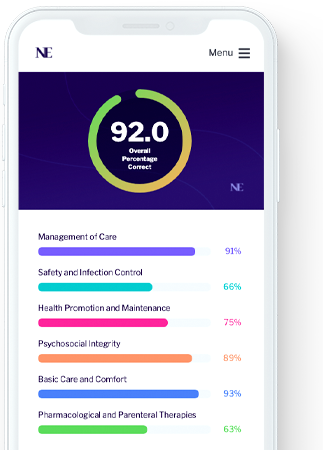7 Types of Alternate-Format NCLEX Questions (and How to Dissect Them) – Part Three
Every nurse has an NCLEX story; in fact I remember my own test very well. I thought it was exceedingly difficult and was certain I’d failed. I got exactly 75 questions and I just knew I’d performed so poorly that the computer probably thought I was a complete idiot. The next 48 hours of waiting for results were some of the longest of my life. I was already mentally planning my study schedule for when I’d have to re-take it.
Luckily, my worrying was unnecessary: I passed. I’ve talked with many nurses over the last ten years, and this appears to be a shared experience. It turns out that a lot of nurses think they failed the NCLEX once the test is done.
Why is this?
The NCLEX is supposed to be hard. None of us know everything. The computer adaptive tests (CAT) are designed to give you difficult questions, in anticipation that you will get some wrong. So as you prepare for the NCLEX, accept that you won’t answer every question perfectly. But as you study and learn the types of questions you can expect on the test, you can be confident that you read each question correctly.
Alternate-format NCLEX questions are a somewhat recent addition to the test. When I took the test back in 2009, these types of questions were only just being introduced. Personally, I thought the test was scary enough without them, but since alternate-format questions are here to stay, we thought it would be a good idea to provide an in-depth look at each type to help familiarize you with them. After all, alternate-format questions are only intimidating because they are different.
This post is part three in a series of five that provide detailed explanations (with examples!) of the seven types of alternate-format NCLEX questions you will see on the exam. In part one, we covered the basics of the NCLEX and introduced alternate-format questions. In part two, we discussed four types of questions that are still fairly similar to standard multiple-choice questions. This article exclusively covers one type: multiple response NCLEX questions. We decided to spend a little extra time with them because they can be tricky. Read on to learn more!
5.) Multiple Response Questions
Test questions with multiple correct answers appear intimidating because most of us are used to selecting only one answer choice. Once you have the option to select multiple correct answers, suddenly they all seem correct. Or is that just me? In any case, when it comes to the NCLEX, the number of correct answers for multiple response questions ranges from a single correct answer to all options being correct, and everywhere in between!
So. Where do you start? First, you need to learn how to identify these questions. They share a lot of similarities with standard multiple-choice questions, but feature some key differences. The most obvious difference is an important phrase embedded within the question itself: select all that apply. You’ll probably find it tacked on to the very end of the question. This phrase alerts the reader that multiple correct answers are possible. Additionally, these questions typically have more than four possible answer choices: often five or six.
Once you identify a question as multiple response, your test strategy will have to change. Think about it this way: when answering a standard multiple-choice question, you need to determine the best answer. Sure, there might be two correct choices, but one of them will always be the best, most correct answer (this is why we all hate the NCLEX). Because multiple response questions have the potential for multiple correct answers, you are no longer looking for the best answer; you have to identify all correct answers.
How? The simplest way to deal with this type of alternate-format question is to remember that multiple response equals true or false. It helps to think of the answer options as a set of true/false statements. You can reframe the multiple response question into something more familiar and less intimidating. Consider the following question:
The nurse is planning care for the patient returning from surgery for a colon resection and ileal pouch-anal anastomosis. Which interventions does the nurse employ to prevent surgical site infection? Select all that apply.
A.) Perform diligent hand hygiene
B.) Hold the patient’s scheduled heparin injections
C.) Administer antibiotics within one hour of returning from surgery
D.) Ensure sequential devices are in place and functional
E.) Encourage the patient to use the incentive spirometer every hour while awake
You’ll notice right away that the question features the key phrase “select all that apply” and contains more than the usual four answer choices. Now that you’ve tagged it as a multiple response question, you need to figure out what it is asking (for more on this, see my post on dissecting NCLEX questions). It helps to rephrase the question into a single sentence, such as this one: “___ will help the nurse prevent surgical site infection for the patient who received a colon resection.”
Then, simply use the rephrased sentence to evaluate each option separately, marking it as true if it completes the sentence or false if it does not. For example: “Performing diligent hand hygiene will help the nurse prevent surgical site infection for the patient who received a colon resection.” This statement is true. Mark it. After using each answer option to complete the sentence, you’ll find that A and C are correct/true.
Choose answers A and C and move on to the next question!
Here’s another example:
The patient has a peripherally inserted central catheter (PICC) for the long-term administration of parenteral nutrition, oxacillin, and gentamicin. Which assessment findings, if present in the patient, indicate the patient is experiencing a complication of the PICC line? Select all that apply.
A.) Tinnitus
B.) Muffled heart sounds
C.) Decreased urine output
D.) Supraventricular tachycardia
E.) Temperature of 103°F/39.4°C
F.) Swelling of the lips and tongue
Again, note the key phrase and extra answer choices. You can easily peg this as a multiple response question. Now, figure out what it is asking and rephrase the question. Your new question may look something like this: “___ indicates a complication of a PICC line.”
Now, insert each answer choice into the rephrased question and determine if it becomes a true or a false statement. “Tinnitus indicates a complication of a PICC line.” This statement is false. Leave it alone and move on to the next option. “Muffled heart sounds indicate a complication of a PICC line.” TRUE!
Once you test each option as a possible answer, you’ll see that B, D, and E are correct/true. The rationale for this is that PICC lines are at risk of several complications, including tip misplacement and infection. Options B and D are potential cardiac rhythm complications of an incorrectly placed PICC catheter tip. Choice E is an indication of infection.
If you’ve never seen a multiple response question before, it’s easy to be intimidated at first glance. It’s hard enough to choose one correct answer to a question, let alone several! Multiple response questions are much easier to handle if you know how to rephrase the question and turn it into something more familiar and manageable. Remember, these questions are simply elaborate true/false questions! That’s not so intimidating. And, as always, the best way to prepare for the NCLEX is to practice.
We still have two types of alternate-format questions to cover in this series. Read on to learn more about ordered response and fill-in-the-blank questions.




